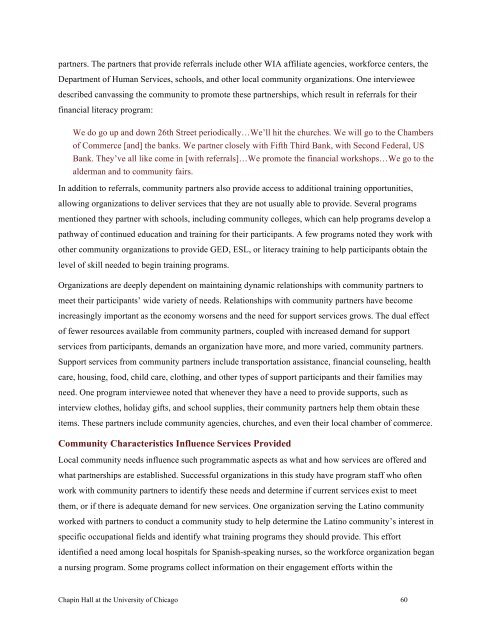Inside the Black Box - Chapin Hall at the University of Chicago
Inside the Black Box - Chapin Hall at the University of Chicago
Inside the Black Box - Chapin Hall at the University of Chicago
- No tags were found...
You also want an ePaper? Increase the reach of your titles
YUMPU automatically turns print PDFs into web optimized ePapers that Google loves.
partners. The partners th<strong>at</strong> provide referrals include o<strong>the</strong>r WIA affili<strong>at</strong>e agencies, workforce centers, <strong>the</strong><br />
Department <strong>of</strong> Human Services, schools, and o<strong>the</strong>r local community organiz<strong>at</strong>ions. One interviewee<br />
described canvassing <strong>the</strong> community to promote <strong>the</strong>se partnerships, which result in referrals for <strong>the</strong>ir<br />
financial literacy program:<br />
We do go up and down 26th Street periodically…We’ll hit <strong>the</strong> churches. We will go to <strong>the</strong> Chambers<br />
<strong>of</strong> Commerce [and] <strong>the</strong> banks. We partner closely with Fifth Third Bank, with Second Federal, US<br />
Bank. They’ve all like come in [with referrals]…We promote <strong>the</strong> financial workshops…We go to <strong>the</strong><br />
alderman and to community fairs.<br />
In addition to referrals, community partners also provide access to additional training opportunities,<br />
allowing organiz<strong>at</strong>ions to deliver services th<strong>at</strong> <strong>the</strong>y are not usually able to provide. Several programs<br />
mentioned <strong>the</strong>y partner with schools, including community colleges, which can help programs develop a<br />
p<strong>at</strong>hway <strong>of</strong> continued educ<strong>at</strong>ion and training for <strong>the</strong>ir participants. A few programs noted <strong>the</strong>y work with<br />
o<strong>the</strong>r community organiz<strong>at</strong>ions to provide GED, ESL, or literacy training to help participants obtain <strong>the</strong><br />
level <strong>of</strong> skill needed to begin training programs.<br />
Organiz<strong>at</strong>ions are deeply dependent on maintaining dynamic rel<strong>at</strong>ionships with community partners to<br />
meet <strong>the</strong>ir participants’ wide variety <strong>of</strong> needs. Rel<strong>at</strong>ionships with community partners have become<br />
increasingly important as <strong>the</strong> economy worsens and <strong>the</strong> need for support services grows. The dual effect<br />
<strong>of</strong> fewer resources available from community partners, coupled with increased demand for support<br />
services from participants, demands an organiz<strong>at</strong>ion have more, and more varied, community partners.<br />
Support services from community partners include transport<strong>at</strong>ion assistance, financial counseling, health<br />
care, housing, food, child care, clothing, and o<strong>the</strong>r types <strong>of</strong> support participants and <strong>the</strong>ir families may<br />
need. One program interviewee noted th<strong>at</strong> whenever <strong>the</strong>y have a need to provide supports, such as<br />
interview clo<strong>the</strong>s, holiday gifts, and school supplies, <strong>the</strong>ir community partners help <strong>the</strong>m obtain <strong>the</strong>se<br />
items. These partners include community agencies, churches, and even <strong>the</strong>ir local chamber <strong>of</strong> commerce.<br />
Community Characteristics Influence Services Provided<br />
Local community needs influence such programm<strong>at</strong>ic aspects as wh<strong>at</strong> and how services are <strong>of</strong>fered and<br />
wh<strong>at</strong> partnerships are established. Successful organiz<strong>at</strong>ions in this study have program staff who <strong>of</strong>ten<br />
work with community partners to identify <strong>the</strong>se needs and determine if current services exist to meet<br />
<strong>the</strong>m, or if <strong>the</strong>re is adequ<strong>at</strong>e demand for new services. One organiz<strong>at</strong>ion serving <strong>the</strong> L<strong>at</strong>ino community<br />
worked with partners to conduct a community study to help determine <strong>the</strong> L<strong>at</strong>ino community’s interest in<br />
specific occup<strong>at</strong>ional fields and identify wh<strong>at</strong> training programs <strong>the</strong>y should provide. This effort<br />
identified a need among local hospitals for Spanish-speaking nurses, so <strong>the</strong> workforce organiz<strong>at</strong>ion began<br />
a nursing program. Some programs collect inform<strong>at</strong>ion on <strong>the</strong>ir engagement efforts within <strong>the</strong><br />
<strong>Chapin</strong> <strong>Hall</strong> <strong>at</strong> <strong>the</strong> <strong>University</strong> <strong>of</strong> <strong>Chicago</strong> 60
















